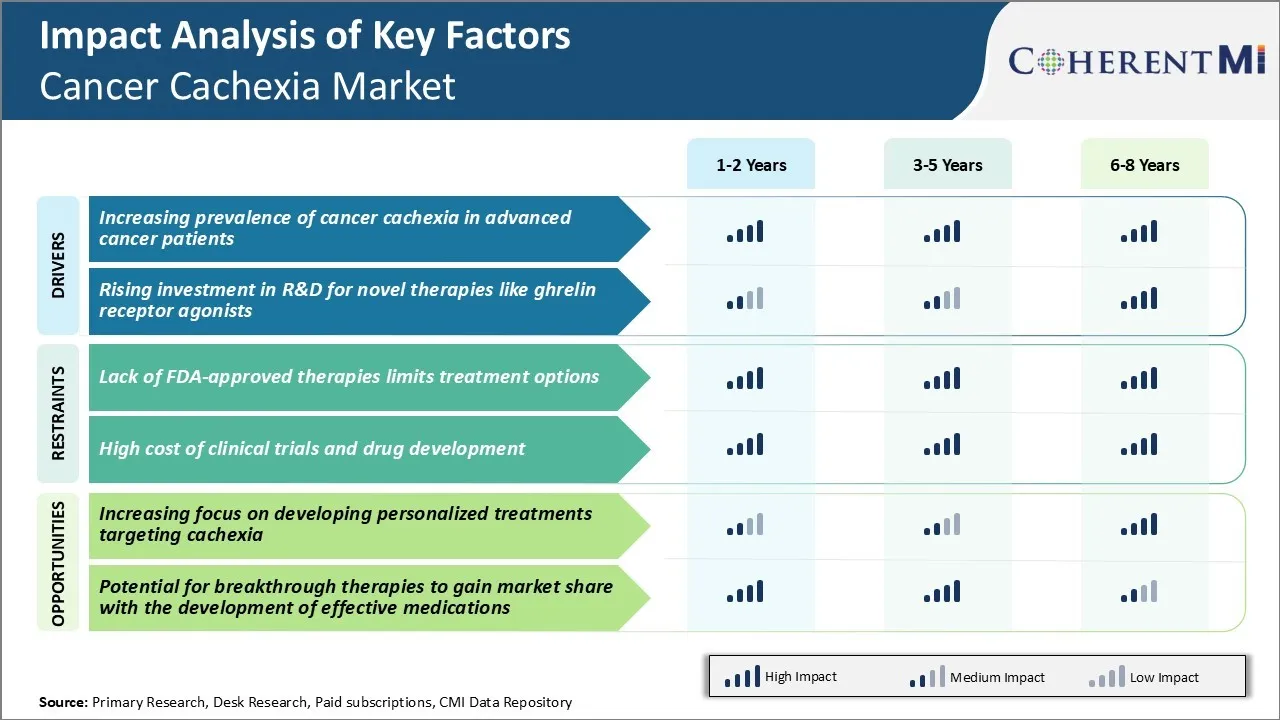Раковая кахексия рынок АНАЛИЗ РАЗМЕРОВ И ДОЛЕЙ - ТЕНДЕНЦИИ РОСТА И ПРОГНОЗЫ (2024 - 2031)
Раковая кахексия Рынок сегментируется по лекарственным средствам (анаболические стероиды, противовоспалительные препараты), по пути администрирования ....
Раковая кахексия рынок Тенденции
Рыночный драйвер - увеличение распространенности раковой кахексии у пациентов с прогрессирующим раком
Число пациентов, страдающих прогрессирующими и метастатическими формами рака, неуклонно растет на протяжении многих лет. Одной из основных сопутствующих заболеваний, связанных с распространенным раком, является кахексия. Кахексия приводит к истощению мышц через различные механизмы, вызванные самим раком или химиотерапией и лучевой терапией, проходящими лечение.
Одновременно рак часто вызывает мальабсорбцию и нарушение нормальных метаболических путей, снижая аппетит и потребление пищи у пациентов. Благодаря современным достижениям в области скрининга и диагностики рака в сочетании с эффективными целенаправленными и иммунотерапией многие пациенты могут выживать дольше даже после постановки диагноза на продвинутой стадии. Однако длительная выживаемость также означает, что пациенты должны справляться с раком в течение длительного времени, что увеличивает вероятность развития кахексии.
Кроме того, подходы к поддерживающей и паллиативной помощи теперь также позволяют многим неизлечимым пациентам жить с управляемыми симптомами, приводящими к росту распространенности кахексии в развитых популяциях рака. Таким образом, с увеличением заболеваемости раком и улучшением показателей выживаемости, особенно в развитых странах, прогнозируется значительный рост заболеваемости, связанной с кахексией. Это представляет собой серьезную проблему лечения, требующую новых терапевтических возможностей для рака кахексии.
Рыночный драйвер - Рост инвестиций в исследования и разработки для новых методов лечения, таких как агонисты рецепторов грелина
Крупные фармацевтические компании и небольшие биотехнологии начали выделять большие средства и ресурсы на разработку эффективных методов лечения рака кахексии. В настоящее время не существует одобренных препаратов, специфичных для индикации кахексии, и лечение включает в себя немаркированное использование общих стимуляторов аппетита или стероидов.
Тем не менее, эти препараты обеспечивают ограниченные преимущества и часто связаны с серьезными побочными эффектами, особенно при длительном использовании. Эта неудовлетворенная клиническая потребность стимулировала обширные исследования молекулярных механизмов, лежащих в основе патологии кахексии. Одной из таких перспективных целей, привлекающих значительный интерес отрасли, является сигнальный путь грелина.
Грелин — это гормон, который обычно вырабатывается в желудке и играет ключевую роль в регуляции аппетита и метаболических функций. Исследования показали, что уровень грелина значительно снижается у пациентов с кахектическим раком. Доклинические исследования подтвердили способность агониста грелиновых рецепторов обратить вспять истощение мышц, увеличить потребление пищи и массу тела в различных моделях кахексии грызунов. Это дало веские основания для разработки аналогов грелина в качестве противокахектических препаратов, способствуя росту рынка раковой кахексии.

Недостаток одобренных FDA методов лечения ограничивает варианты лечения
Рынок раковой кахексии сталкивается со значительными проблемами из-за отсутствия одобренной FDA лекарственной терапии, специально предназначенной для лечения потери веса и истощения мышц, связанных с раком. В настоящее время нет лекарств, одобренных FDA для лечения кахексии, связанной с раком или другими хроническими заболеваниями.
Единственными доступными вариантами являются в основном стимуляторы аппетита или кортикостероиды, которые имеют ограниченную эффективность и сопряжены со значительными рисками безопасности при длительном использовании. Это оставляет онкологов и пациентов без адекватных терапевтических альтернатив для эффективного лечения кахексии. Отсутствие одобренных методов лечения также препятствует усилиям фармацевтических компаний по дальнейшему инвестированию в исследования и разработки в направлении более эффективного и безопасного лечения кахексии.
Для лучшего понимания патофизиологии кахексии и выявления перспективных кандидатов на лекарства, которые могут получить одобрение регулирующих органов и трансформировать уход за пациентами, необходимы дополнительные клинические исследования и сотрудничество между разработчиками лекарств.
Рыночная возможность: повышение внимания к разработке персонализированных методов лечения кахексии
Растущая осведомленность и понимание рака кахексии открывает привлекательные возможности для компаний, работающих на этом рынке. В онкологическом пространстве все больше внимания уделяется разработке более персонализированных методов лечения, которые касаются конкретных биологических механизмов, лежащих в основе раковой кахексии отдельных пациентов.
Несколько биотехнологических компаний и крупных фармацевтических фирм участвуют в клинических испытаниях, оценивающих новые соединения, нацеленные на множественные пути кахексии, такие как воспаление, метаболическая дисрегуляция и анорексия. Они также изучают возможности для комбинаций с существующими онкологическими препаратами. Этот набор потенциальных новых методов лечения породил оптимизм в отношении того, что в ближайшем будущем могут быть доступны более безопасные и эффективные варианты лечения кахексии.
По мере развития исследований в области биомаркеров и персонализированного скрининга кахексии фармацевтические компании могут также идентифицировать подгруппы пациентов, которые наиболее склонны реагировать на определенные целевые методы лечения. Такие точные подходы могут помочь оптимизировать разработку методов лечения и достичь лучших клинических результатов при раковой кахексии.